Canale L.C.F., Mesquita R.A., Totten G.E. Failure Analysis of Heat Treated Steel Components
Подождите немного. Документ загружается.

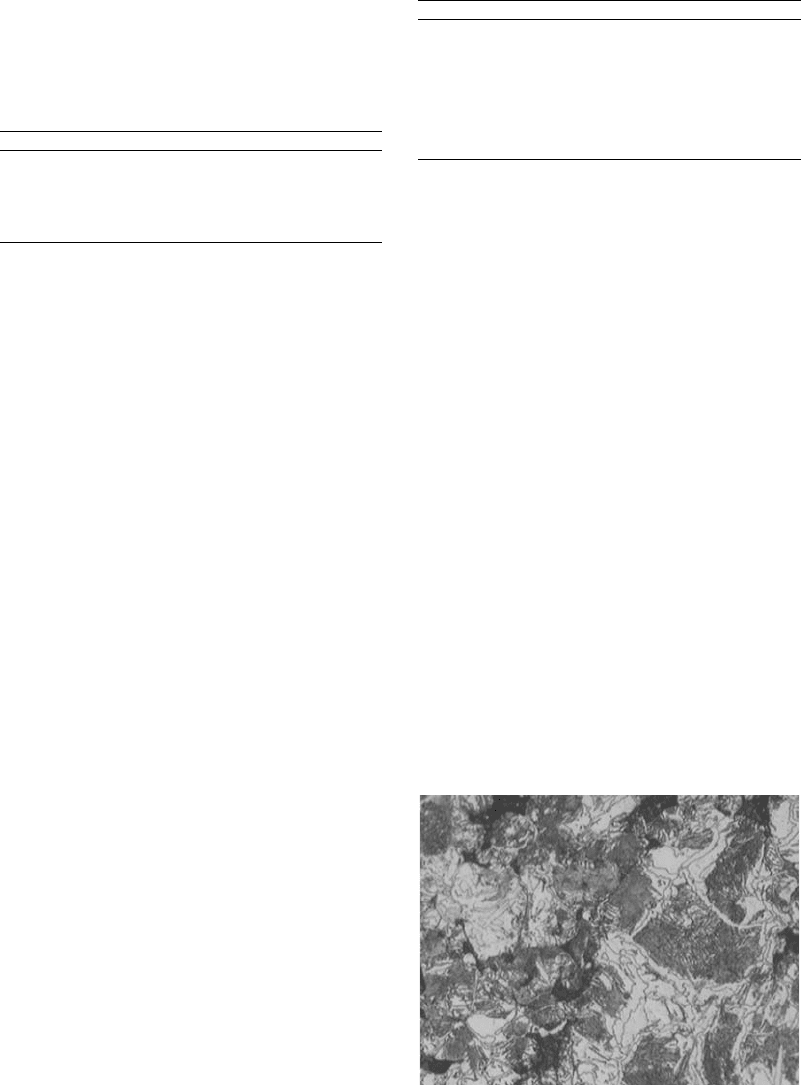
cylinder head of a sport utility vehicle. It was
observed that the valve seats were expanding
during shrink-fitting instead of contracting.
This resulted in interference between the
valve seat and the cylinder head, causing rejec-
tion of the cylinder heads. The parameters that
can cause dimensional instability during shrink-
fitting are:
Operation 4M parameter Observations
Powder chemistry Not applicable ...
Blending Not applicable ...
Compaction Not applicable ...
Sintering Not applicable ...
Tempering High retained austenite Yes
A significant amount of retained austenite
was observed even after tempering. This
retained austenite was transforming to marten-
site during shrink-fitting, where the products
were cooled to 60
C, which resulted in a
volume expansion.
Corrective Measures. A complete trans-
formation of retained austenite can be effected
by:
Multiple tempering
Cooling to below the martensite finish tem-
perature (in this case, a deep cryogenic
treatment)
Combination of tempering and deep cryo-
genic treatment
Trials revealed that a combination of subzero
treatment and tempering gave the best results
with respect to dimensional stability as well as
metallurgical properties.
Results. The valve seats subjected to a
combination of subzero treatment and tem-
pering did not expand during shrink-fitting.
Further dimensional measurements taken
at 60
C were in line with the theoretically
calculated shrinkage in contrast to the earlier
expansion.
Case Study 5: Wear after Sintering
Bushes were produced with Fe-0.45%P–
2%Cu-2.5%C and supplied in the oil-impreg-
nated condition. These bushes were deliberately
undersintered so that some free graphite was
retained, which acted as a solid lubricant that
in turn minimized wear in application. The
parameters that can cause wear of a free-graphite
bush are:
Operation 4M parameter Observations
Powder chemistry Not applicable ...
Blending Not applicable ...
Compaction High density No
Sintering High sintering temperature Yes
High sintering time No
Cementite network Yes
Insufficient free graphite Yes
Oil impregnation Low oil content No
Metallography of the worn sample revealed a
cementite network in the product (Fig. 14). This
is a clear indication that excess carbon had gone
into solution, which resulted in the solid lubri-
cant being depleted.
Corrective Measures. Sintering was carried
out at 1080
C for 20 min, which resulted
in excess combined carb on. The temperature
was reduced so that the combined carbon
was 50.8%. The sintering temperature for the
product was fixed at between 1040 and 1060
C
Results. Bushes sintered at 1060
C
for 20 min resulted in a pearlitic-steaditic
microstructure with no cementite network
(Fig. 15).
Case Study 6: Fracture of Steam-Treated
Part
Valve plates for compressors were subjected
to grinding after steam treatment. Fracture of
a steam-treated valve plate was observed during
grinding after steam treatment. The parameters
Fig. 14
Pearlite-steadite microstructure with cementite net-
work
Failure Analysis of Powder Metal Steel Components / 407
Name ///sr-nova/Dclabs_wip/Failure_Analysis/5113_395-415.pdf/Chap_12/ 18/8/2008 3:53PM Plate # 0 pg 407
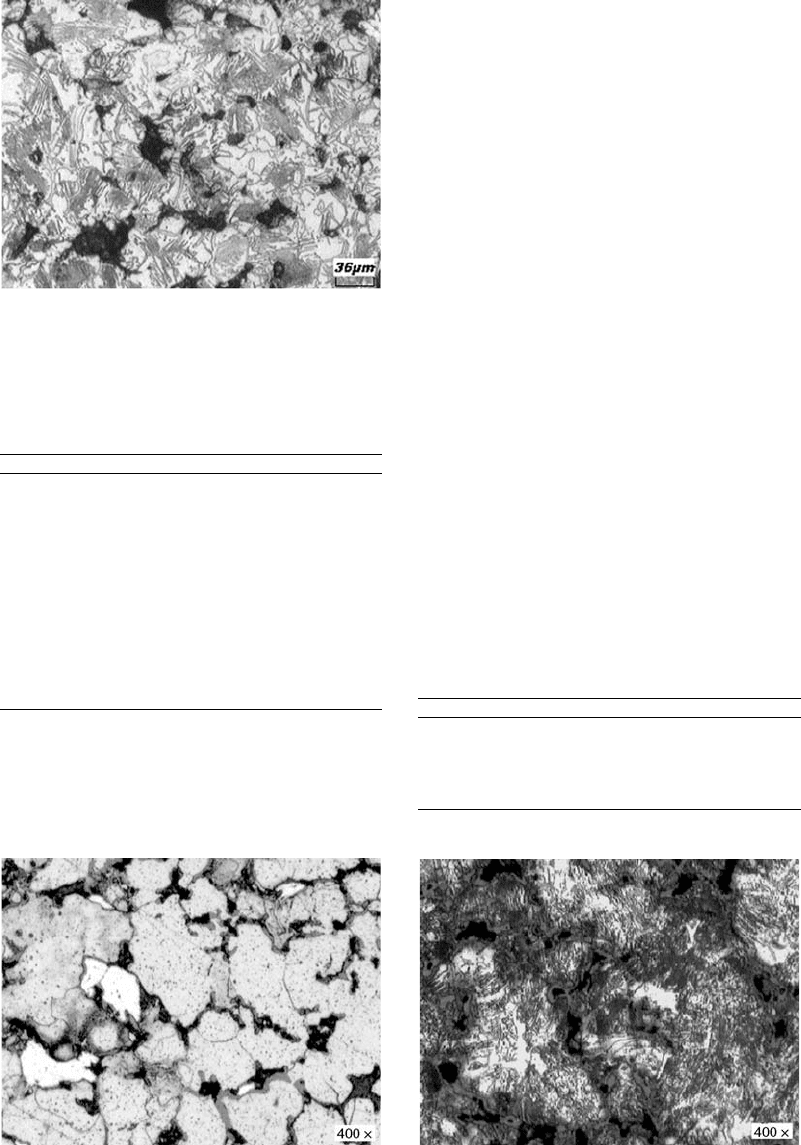
that can cause the fractu re of a steam-treated
part are:
Operation 4M parameter Observations
Powder chemistry Not applicable ...
Blending Not applicable ...
Compaction Low density No
Sintering Low sintering temperature No
Low soaking time No
Oxidizing atmosphere No
Decarburizing atmosphere No
High dewaxing temperature No
Overloading of parts Yes
Steam treatment High temperature No
Insufficient steam No
Low soaking time No
Overloading of parts No
Masking of parts No
Hardness measurements reveale d very low
hardness. Product with hardness conforming to
specification and product with low hardness
were subjected to standard metallographic
analysis. The product with low hardness
revealed a predominantly ferritic structure with
free copper (Fig. 16), even though the blend
graphite addition was 0.8% (Fig. 17). Thus,
undersintering was suspected to be the possible
cause. However, the sintering control charts
revealed that the temperature as well as the
belt speed were meeting the specifications.
The loading pattern was then checked. It was
observed that the loading pattern followed
that which was recommended for a 46 cm
(18 in.) belt, whereas the belt width was 30 cm
(12 in.). This resulted in overloading of
parts, which consequently resulted in under-
sintering.
Corrective Measures. Suitable one-point
lessons were imparted to the sintering operators
to ensure that the right process plans were fol-
lowed.
Case Study 7: Oxidation after Sintering
Exhaust valve seats for internal combustion
engines are produced with a chromium-rich
hard-phase alloy. The hard-phase alloy is
essential for wear resistance at elevated tem-
peratures, to which the exhaust valve seat
is subjected. Oxidation of the hard phase was
observed after sintering. The parameters that can
cause oxidation after sintering are:
Operation 4M parameter Observations
Powder chemistry Chromium-ri ch alloy Yes
Blending Not applicable ...
Compaction Rusted compacts No
Sintering High rapid burnoff temperature Yes
High cooling zone dewpoint Yes
Fig. 16
Low-hardness sample with almost no combined
carbon. Only ferrite and free copper are observed.
Fig. 17
Typical micros tructure with ~0.7% combined
carbon
Fig. 15
Pearlite-steadite microstructure free from cementite
network
408 / Failure Analysis of Heat Treated Steel Components
Name ///sr-nova/Dclabs_wip/Failure_Analysis/5113_395-415.pdf/Chap_12/ 18/8/2008 3:53PM Plate # 0 pg 408
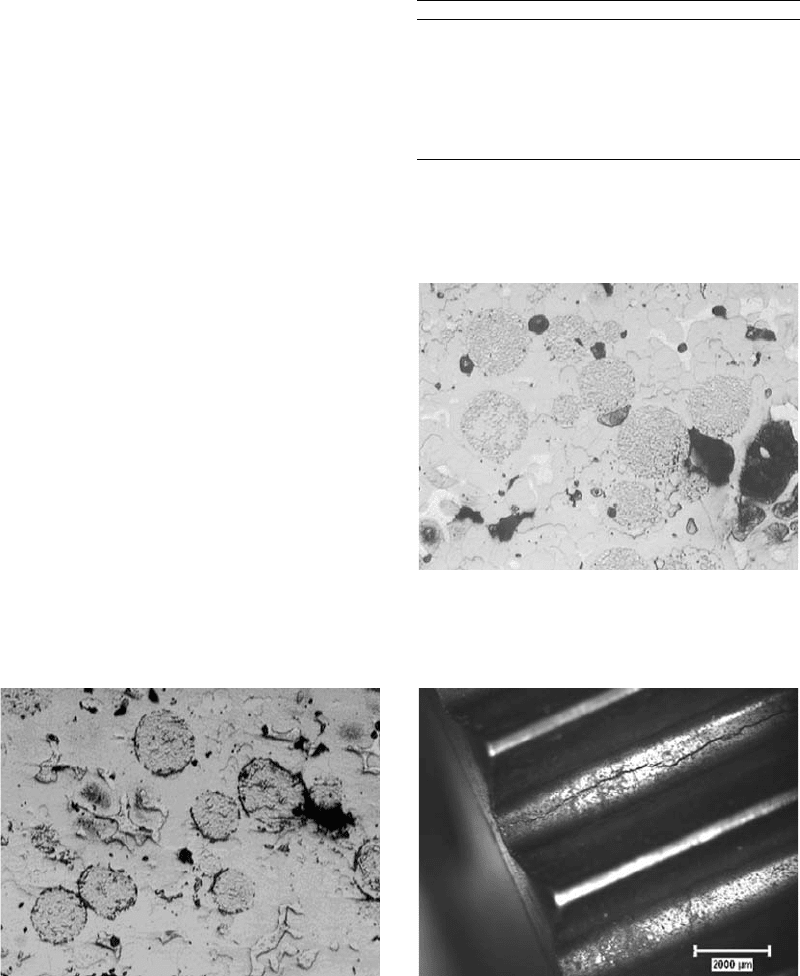
Chromium-rich particles are susceptible to
oxidation when the product is heated and cooled
in the range of 650 to 1050
C. Oxidation of the
hard-phase particles is favored by:
High rapid burnoff temperature
High cooling zone dewpoint
Figure 18 shows the microstructure with
oxidized hard-phase particles. The oxide film
around the hard phase does not allow the hard
phase to interact with the matrix. As a result, the
matrix will not have chromium carbides, which
helps the valve seats to retain wear resistanc e at
high temperatures. The rapid burnoff temper-
ature was observed to be 650
C, and the cooling
zone dewpoint was between 20 to 30
C.
These are potential causes for oxidation.
Corrective Measures. The furnace was
allowed to stabilize for a period of 4 to 16 h. The
gas ratio was maintained at 70% N
2
and 30% H
2
during this period, and the gas volume was
increased by ~25%. The rapid burnoff tem-
perature was restricted below 600
C. The valve
seats were sintered when the operating dewpoint
in the hot and cooling zones is 35
C or lower.
Results. The modification in sintering para-
meters resulted in the production of oxidation-
free valve seats (Fig. 19).
Case Study 8: Cracks after Induction
Hardening
A PM transmission gear was subject ed to
induction hardening for an application that
demanded high wear resistance as well as high
contact and bending strength. The gear had an
Fe-Cu-C chemistry and was compacted to a
density of 7 g/cc. Subsequently, the gear was
sintered, and a sizing operation was then carried
out for dimensional correction. Induction hard-
ening of the gear was carried out after sizing, and
cracks were observed after induction hardening.
The parameters that can cause cracks after
induction hardening are:
Operation 4M parameter Observations
Powder chemistry High carbon Yes
Blending Not applicable ...
Compaction Low density No
Sintering Low sintering temperature No
Low sintering time No
Sizing Not applicable ...
Induction hardening High heating time No
Severe quench No
Figure 20 shows the crack. This crack origi-
nates in the middle of the root of the gear and
Fig. 19
No oxide layer observed in the hard-phase particles
after implementation of corrective measures
Fig. 20
Crack in the middle of the root of the primary driven
gear
Fig. 18
Exhaust valve seat with oxidized hard-phase
particles
Failure Analysis of Powder Metal Steel Components / 409
Name ///sr-nova/Dclabs_wip/Failure_Analysis/5113_395-415.pdf/Chap_12/ 18/8/2008 3:53PM Plate # 0 pg 409
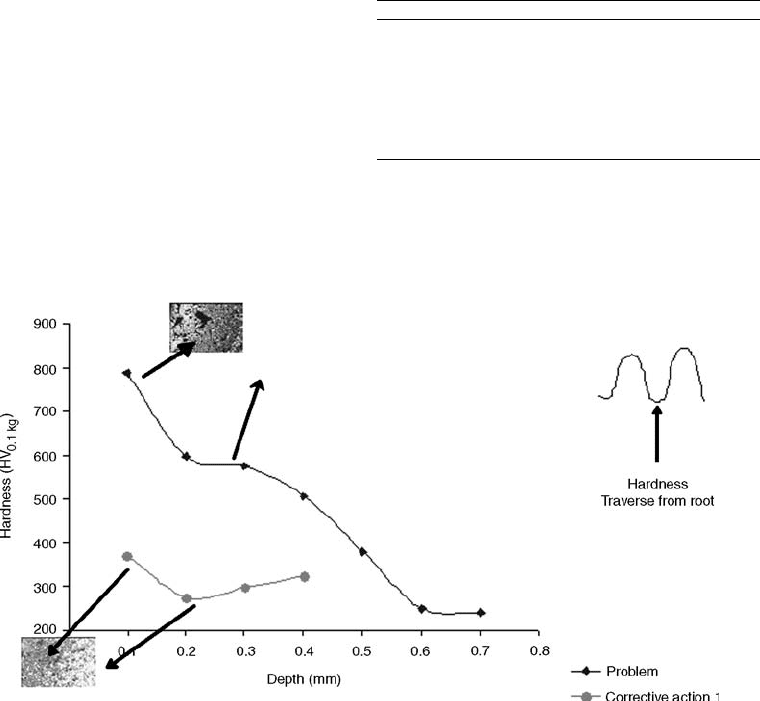
does not originate at any sharp corners. Hardness
profiles from the root indicated that the root has
been hardened to a very high hardness (Fig. 21),
compared to the earlier sample in which no crack
was observed. Microstructure near the root
revealed untempered martensite, which gradu-
ally became a mixture of martensite and bainite
and subsequently ferrite and pearlite. This is in
contrast to the earlier sample where the root was
not hardened and had a bainitic structure. Sec-
ondly, the combined carbon estimated from the
pearlite content in the sintered microstructure
was 0.7% compared to 0.6% in the product
that was successfully induction hardened. The
strain caused by the martensitic transformation
increases in proportion to the combined carbon
in the microstructure. Thus, the possible causes
for the crack were:
Too high a soaking time, which resulted in a
severe quench
High combined carbon in the sintered
microstructure
Corrective Measures. The formation of
martensite in the root was a result of quenching
from very high temperatures. The time was
reduced, and the coil design and quench were
modified. However, the martensitic micro-
structure coul d not be avoided in the root, and
cracking was still observed. It was concluded
that the product was unable to withstand the
stresses associated with the transformation. The
carbon content was reduced in the blend to 0.6%,
which resulted in a lesser volumetric strain due
to martensitic transformation in the product.
Induction hardening with this chemistry yielded
no cracks, and the hardness traverse matched
that obtained in the rapid prototype samples.
Results. Products with a lower combined
carbon content did not crack when induction
hardened.
Case Study 9: Cracks after Quenching
A flyweight for a governor assembly in a
diesel engine was carbonitrided to meet the
product requirements for strength. This is a
complex part wherein multiple punches are used
to form the sections of different thicknesses.
The product was observed to crac k after carbo-
nitriding. The parameters that can cause cracks
after quenching are:
Operation 4M parameter Observations
Powder chemistry Not applicable ...
Blending Not applicable ...
Compaction High density difference No
Underfilling of powder Yes
Sintering Low sintering temperature No
Low sintering time No
Carbonitiriding High hardening temperature No
Severe quench No
The parts were subjected to magnetic particle
inspection prior to heat treatment. No cracks
were observed. Metallography was then carried
Fig. 21 Hardness traverse from root
410 / Failure Analysis of Heat Treated Steel Components
Name ///sr-nova/Dclabs_wip/Failure_Analysis/5113_395-415.pdf/Chap_12/ 18/8/2008 3:53PM Plate # 0 pg 410
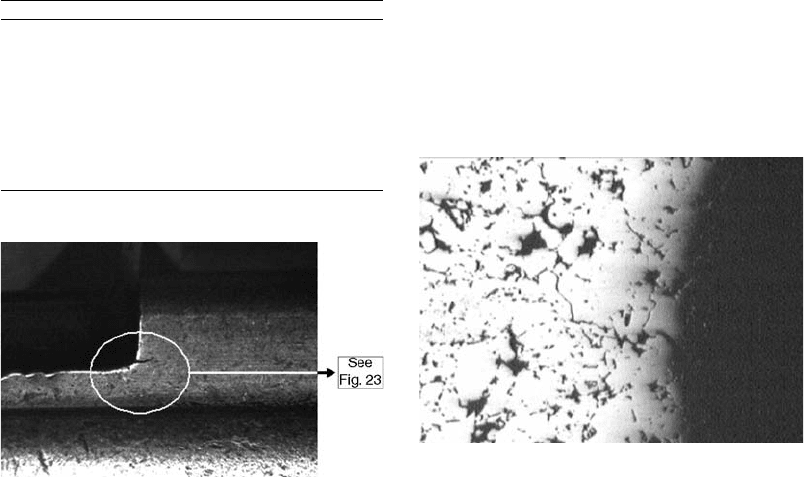
out at the location where the crack occurred in
heat treatment. This is shown in Fig. 22. Insuf-
ficient powder filling was observed (Fig. 23).
The underfill results in a localized region of low
strength, which gives way during subsequent
quenching and results in crack formation.
Corrective Measures. The localized under-
filling was due to the presence of a sharp corner
in the tool. A trial was conducted wherein the
sharp corner was smoothed by filing the parts.
No crack was observed after carbonitriding. It
was resolved to increase the radius in the tool so
that a sharp corner and consequently an underfill
are avoided. Products thus produced were heat
treated, and no cracks were observed.
Results Products produced with an improved
radius in the tool resulted in elimination of
product rejections due to quench cracks.
Case Study 10: Dimensional Change
in Carbonitriding
An angle lever for a diesel inject ion pump was
produced with FD-02-00 chemistry and carbo-
nitrided to a case depth of 0.2 to 1.2 mm. When
the carbonitriding was established at a new heat
treatment source, it was observed that the bore
did not shrink sufficiently during carbonitriding.
The parameters that could cause a dimensional
change in carbonitriding are:
Operation 4M parameter Observations
Powder chemistry Not applicable ...
Blending Not applicable ...
Compaction Bore undersized due to tool wear No
Sintering High sintering temperature No
High sintering time No
Carbonitiriding Low soaking time Yes
Insufficient carbon and nitrogen
enrichment
No
High quench oil temperature No
Insufficient transformation Yes
Carbonitriding was carried out at 840
C for
45 min with a carbon potential of 0.8% in the
atmosphere. In the case of the vendor, better
furnace gas sealing ensured that this case depth
was achieved in 20 min. The hardness traverse
indicated that the longer soaking time had a
higher carbon martensite in the case as well as
a higher core hardness, which in turn resulted in
a case depth at the lower end of the specification
for a lower soaking time. This is shown in
Fig. 24.
Corrective Measures. Higher shrinkage is
ensured by a higher amount of martensitic
transformation. This was ensured by increasing
the soaking time from 20 min to 45 min. The
increased soaking time resulted in better expo-
sure of the product to carbon and nitrogen
enrichment, which in turn resulted in higher
martensite content and the desired level of
dimensional shrinkage.
Results. The increased martensite content
resulted in increased volume expansion. Thus,
the shrinkage in the bore is higher with a
soaking time of 45 min. Products soaked at
840
C for 45 min were found to shrink suffi-
ciently, and dimensions conformed to specifi-
cations.
Case Study 11: Low Surface Hardness
after Carbonitriding
Low surface hardness was observed in
an iron-copper part after carbonitriding. The
Fig. 23
Metallography of the region where the crack occur-
red in the sintered sample, showing a pre-existing
defect caused by poor powder filling
Fig. 22 Quench crack in flyweight
Failure Analysis of Powder Metal Steel Components / 411
Name ///sr-nova/Dclabs_wip/Failure_Analysis/5113_395-415.pdf/Chap_12/ 18/8/2008 3:53PM Plate # 0 pg 411
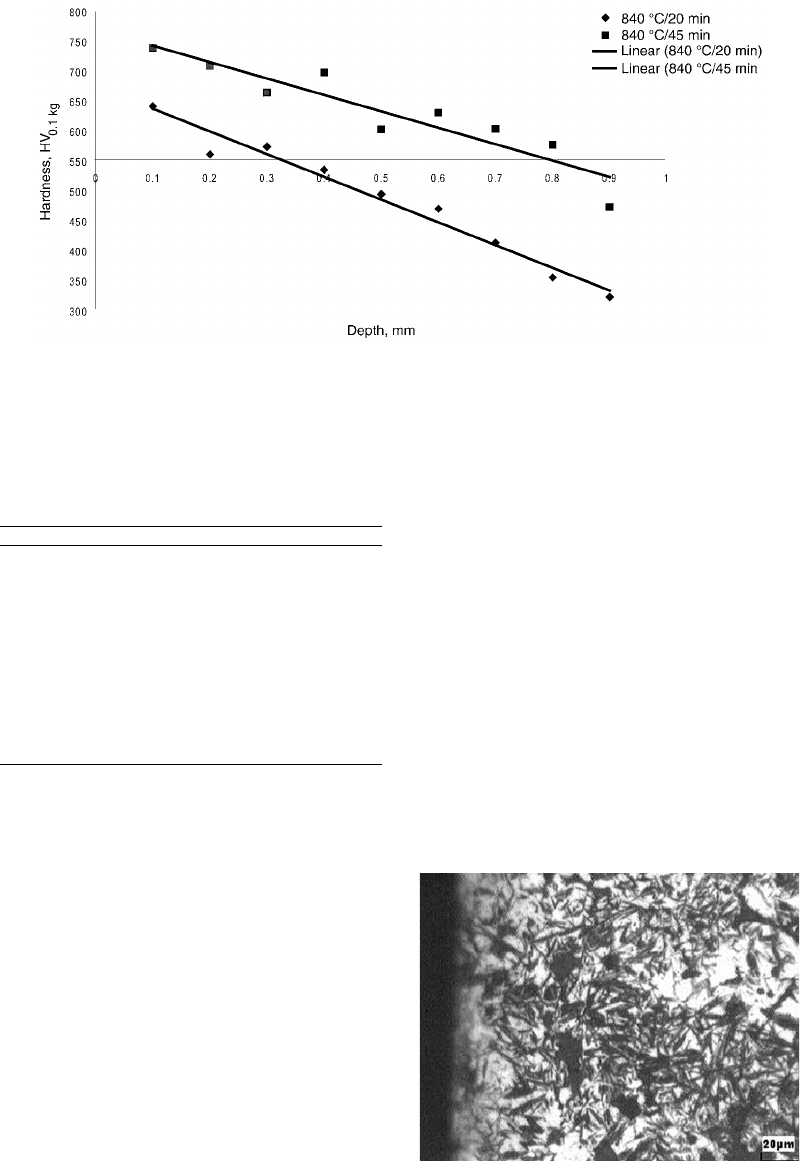
parameters that can cause low surface hardness
after carbonitriding are:
Operation 4M parameter Observations
Powder chemistry Not applicable ...
Blending Not applicable ...
Compaction Low density No
Sintering Low sintering temperature No
Low sintering time No
Carbonitiriding Low soaking time No
Insufficient carbon and
nitrogen enrichment
No
Excess carbon and nitrogen
enrichment
Yes
Delayed quench No
Pearlite/bainite in case No
High retained austenite Yes
After ensuring that the density conformed
to specification, the low-hardness products
were subjected to metallographic analysis. The
case microstructure revealed a high amount
of retained austenite, which is the cause of low
hardness (Fig. 25). High retained austenite
can result if the carbon potential as well as
the nitrogen potential are high. The oxyprobe,
which senses the carbon potential, was exam-
ined and found to be covered with soot. This
resulted in improper sensing of carbon potential,
leading to an excess of active carbon in the
furnace atmosphere, which in turn resulted in
high retained austenite.
Corrective Measures. The temporary cor-
rective measure adopted to salvage the parts
was to carr y out a deep freeze, because repro-
cessing may result in scrapping of the product
due to dimensional distortion. On a permanent
basis, a periodic preventive maintainence
schedule for the oxyprobe was drawn up and
adhered to.
Results. Correcting the oxyprobe yielded
products with a martensitic/510% retained
austenite structure that met the requirements for
surface hardness.
Case Study 12: Variation in Bore Diameter
after Heat Treatment
A valve retainer for a shock absorber was
produced from an FC-02-08 blend that was
hardened for wear resistance. High ovality was
observed after heat treatment. This resulted in
~10% of the products being out of specification.
Fig. 25 High retained austenite in the case
Fig. 24 Hardness traverse in bell crank lever
412 / Failure Analysis of Heat Treated Steel Components
Name ///sr-nova/Dclabs_wip/Failure_Analysis/5113_395-415.pdf/Chap_12/ 18/8/2008 3:53PM Plate # 0 pg 412

The parameters that can cause a wide variation
in bore diameter after heat treatment are:
Operation 4M parameter Observations
Powder chemistry Excess copper content No
Blending Elemental additions No
Compaction Low density No
Sintering Low sintering temperature No
Low sintering time No
Carbonitiriding Volume expansion due to
martensitic transformation
Yes
Thermal contraction during
quenching
Yes
The ovality was checked after sintering and
after heat treatment. The data revealed that
hardening contributes significantly to distortion,
and the contribution of sintering is negligible.
Thermal contraction due to quenching and the
accompanying martensitic phase transformation
contributed significantly to the distortion.
Corrective Measures. To minimize the
distortion, it was reso lved to eliminate the
hardening operation and achieve the required
hardness in sintering. Prealloyed powder con-
taining nickel and molybdenum, blended spe-
cially to produce products with negligible
distortion after sintering, was adopted to achieve
both the hardness and dimensions after sintering.
Results. Changing the process from con-
ventional hardening to sinter hardening reduced
the dimensional spread to 50% of the variation
observed in products with a separate heat treat-
ment operation.
Case Study 13: Low Breaking Load after
Carbonitriding
A component for a gearbox application pro-
duced with a chemistry of FD-02-00 and having
an overall density of 7.2 g/cc was subjected
to carbonitriding to meet the product require-
ments for wear and mechanical strength. During
assembly, the product failed by fracture. The
parameters that can cause low breaking load
after carbonitriding are:
Operation 4M parameter Observations
Powder chemistry Not applicable ...
Blending Not applicable ...
Compaction Low density No
Low sectional density Yes
Sintering Low sintering temperature No
Low sintering time No
Carbonitiriding High carbonitriding temperature Yes
High time of carbon potential
attainment
Yes
Variation in batch quantity Yes
Martensite in core Yes
No case depth inspection
in thin section
Yes
Low breaking load indicated poor toughness
of the product. Poor toughness is related to both
microstructure and density. Lower densities
and a through-hardened microstructure with
martensite in the core can cause premature
fracture. Metallography was carried out in dif-
ferent sections of the failed product. Metallo-
graphy of the sections indicated that the thinner
sections in the product were through hardened.
Figure 26 shows the through-hardened micro-
structure. Sectional density measurements indi-
cated that the thicker sections had a density of
47.2 g/cc, and the thinner sections had a density
of 7.1 g/cc.
However, this through hardening of thinner
sections was not observed in the initial samples
that were tested. To determine the cause of this
variation across different heat treated batches,
the carbon potential attainment was studied for
various batches.
During establishment of the carbonitriding
process, the process parameters were fixed for
~500 parts. The same was subsequently fixed
for the full batch quantity of 3500. In this par-
ticular case, the carbon potential pick up in the
furnace was completely different for the trial
and bulk. Figure 27 shows the difference in
carbon potential pickup. There is a significa nt
difference in the time for attainment of a carbon
potential of 0.8%. Longer times between 0.6 and
0.8% in the bulk lots result in additional carbon
pickup, which resulted in through hardening of
the thinner sectio ns.
Corrective Measures. The carbonitriding
temperature and time were reduced. The batch
quantity was fixed. The density in the compo-
nent was increased to 7.2 g/cc min in all
Fig. 26 Martensite in the core of thin sections in the product
Failure Analysis of Powder Metal Steel Components / 413
Name ///sr-nova/Dclabs_wip/Failure_Analysis/5113_395-415.pdf/Chap_12/ 18/8/2008 3:53PM Plate # 0 pg 413
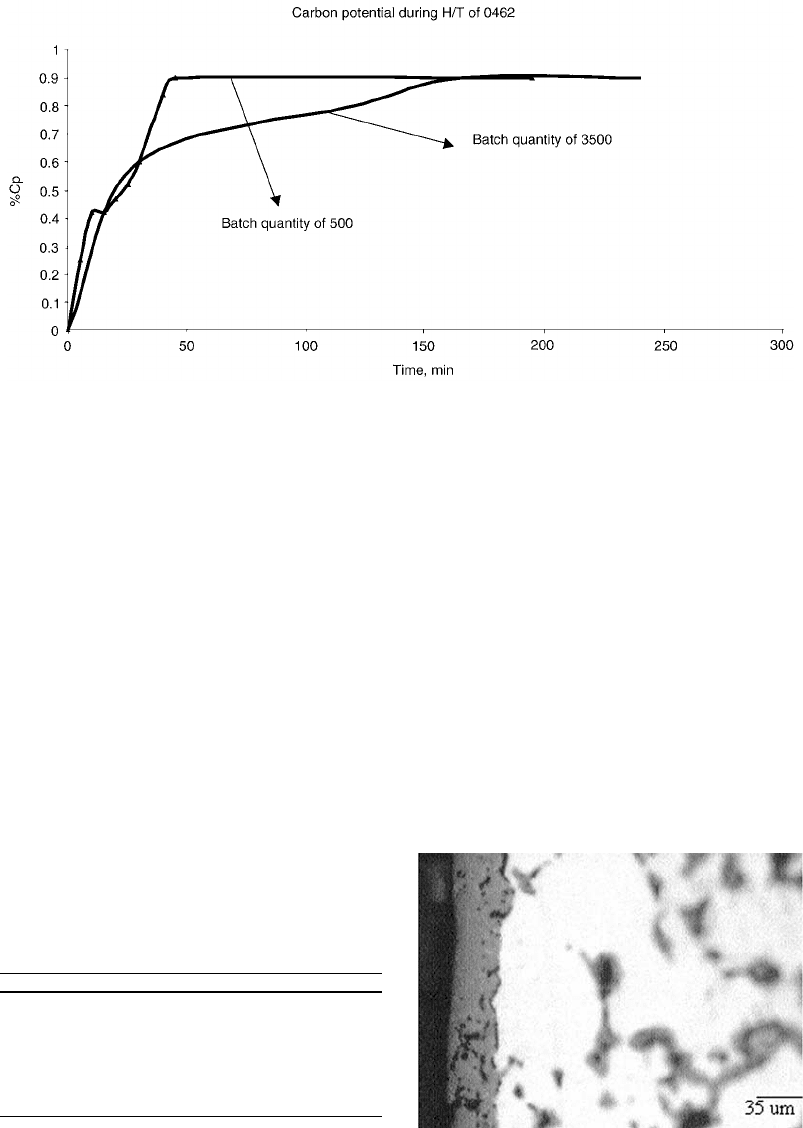
sections, which ensured closure of intercon-
nected pores. Inspection standards for sectional
density and case depth measurements in the
thinner section were introduced so that any
nonconformance would be detected and not
reach the customer.
Results. The corrective measures resulted in
a pearlitic-bainitic microstructure in the core of
the thin section, and the toughness and, conse-
quently, the breaking load were achieved con-
sistently.
Case Study 14: Dimensional Change in
Steam Treatment
Pistons having a density of 7 g/cc were steam
treated for wear resistance and corrosion resist-
ance. During steam treatment, it was important
that the bore dimensions be maintained within
specification. It was observed that after steam
treatment, the bore was undersized. The para-
meters that can cause dimensional change in
steam treatment are:
Operation 4M parameter Observations
Powder chemistry Not applicable ...
Blending Not applicable ...
Compaction Not applicable ...
Sintering Not applicable ...
Machining Bore undersized No
Steam treatment High temperature Yes
Thick oxide layer Yes
After ensuring that the machined dimensions
of the bore were in accordance with specification
prior to steam treatment, metallography was
carried out on the samples with the undersized
bore. An oxide layer of up to 15 mm was
observed (Fig. 28). Typically, Fe
3
O
4
layers are
3to5mm, because the lattice of Fe
3
O
4
does not
allow further diffusion of oxygen molecules
once this layer is formed. Such a thick layer is
due to the formation of Fe O. The steam treat-
ment set temperature was 560
C for this pro-
duct. Because the Fe
3
O
4
reaction is exothermic,
the temperature of the products exceeded
570
C, resulting in the formation of FeO.
Corrective Measures. The steam treat-
ment temperature was subsequently reduced to
530
C, where an oxide layer of 4 to 6 mm was
obtained (Fig . 29). This resulted in the bore
dimensions meeting the specification.
Fig. 27 Difference in carbon potential attainment for change in batch quantity
Fig. 28
Thick oxide layer indicative of FeO formation that
was obtained at a steam treatment temperature of
560
C
414 / Failure Analysis of Heat Treated Steel Components
Name ///sr-nova/Dclabs_wip/Failure_Analysis/5113_395-415.pdf/Chap_12/ 18/8/2008 3:53PM Plate # 0 pg 414
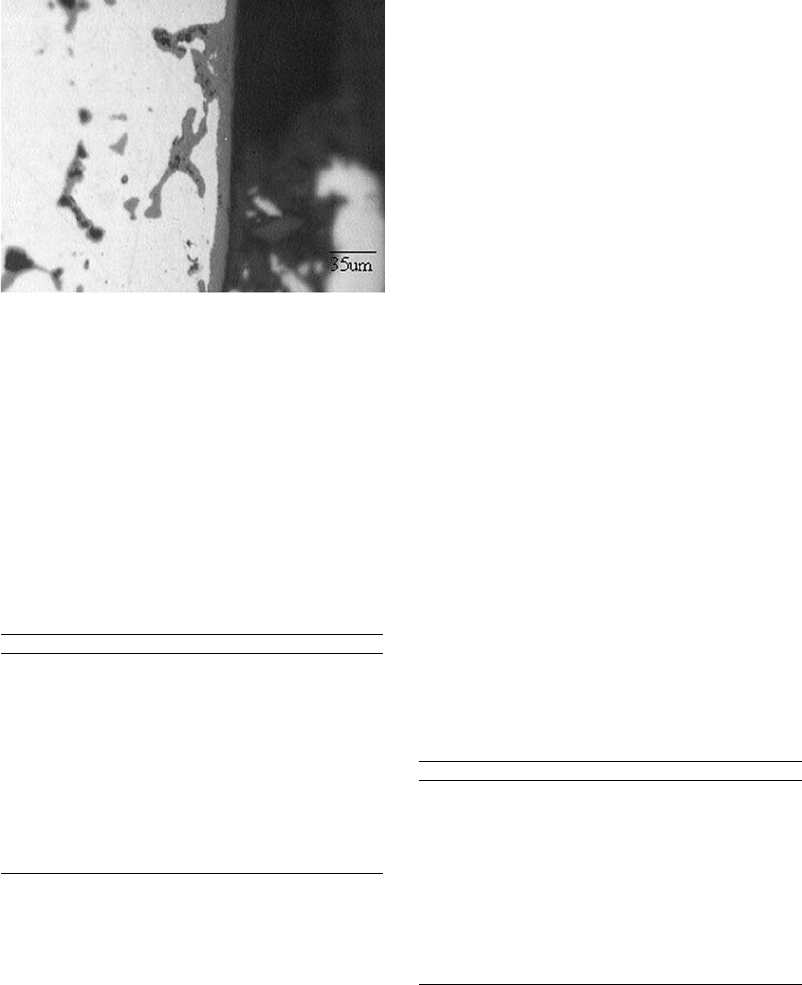
Case Study 15: Low Core Hardness after
Steam Treatment
Crankshaft sprockets with an Fe-Cu-C
chemistry and a density of 6.6 to 6.8 g/cc were
supplied in the steam-treated condition. The
customer demanded that the hardness in the
surface and core meet the specification of
140 HV
10
min. The parameters that can cause
low core hardness after steam treatment are:
Operation 4M parameter Observations
Powder chemistry Low carbon Yes
Blending Not applicable ...
Compaction High density No
Sintering Low sintering temperature No
Low sintering time No
High ferrite content Yes
Sizing Closed surface pores No
Oil in pores Yes
Steam treatment Insufficient time Yes
Low temperature Yes
High temperature (4570
C) No
Masking of products Yes
Nonuniform steam circulation No
It was observed that within a batch, some
products had a core hardness greater than 140
HV
10
. Low and high core hardness samples were
subjected to metallography. It was observed that
higher-hardness samples had better steam
penetration compared to low-hardness samples.
Corrective Measures. To ensure higher
core hardness, the products required greater
exposure to steam. This was achieved by chan-
ging the steam treatment temperature and time
from 530
C/30 min to 550
C/2 h. Masking of
products can also potentially prevent uniform
exposure to steam. To eliminate masking, the
loading pattern was changed from a double layer
to a single layer. However, even after increasing
the steam exposure time and improving the
loading pattern, variation of hardness was
observed within the same batch. A trial was
conducted wherein oil-free sintered samples
were steam treated with sized and oiled parts. It
was observed that the sintered samples have
uniform steam penetration, and the thickness of
the steam oxide layer is uniform throughout the
part. This is in contrast to the sized products with
low core hardness, wherein the oxide layer is
minimal. The presence of oil or a related organic
residue was suspected of interfering with the
steam penetration. An oil that has a higher
volatile content and a lower organic residue
content was used for rust prevention, and the
same was used as a lubricant in sizing. The
change of oil resulted in a core hardness con-
forming to specification. However, the hardness
obtained ranged from 145 to 190 HV. The pre-
sence of products with hardness marginally
above 140 HV
10
indicated that the hardness
must exceed 160 HV to avoid the chances
of core hardness going below specification.
This additional improvement in hardness
was achieved by having a completely pearlitic
microstructure instead of a ferrite+pearlite
microstructure, which was effected by a blend
addition of 0.8% C.
Results. Implementation of the corrective
measures resulted in the core hardness being
achieved consisently in accordance with speci-
fication, as follows:
Properties Specification Before After
Surface
hardness
140
HV
10 min
152–208 185–235
Core hardness 140
HV
10 min
110–173 170–207
Sintered
microstructure
... Ferrite+
pearlite
100% pearlite
Steam-treated
microstructure
... Incomplete
steam
penetration
with low-oxide
layer52 mm
in core
Complete steam
penetration with
oxide layer of
4–6 mm in core
REFERENCES
1. Asm Handbook, Volume 7, Powder Metal
Technologies and Applications, 1998
2. E. Klar and P. Samel, Powder Metallurgy
Stainless Steels: Processing, Micro-
Structures, and Properties, ASM Interna-
tional, 2007
Fig. 29
Oxide layer of 6 mm, indicative of Fe
3
O
4
obtained on
reduction of the steam treatment temperature to
530
C
Failure Analysis of Powder Metal Steel Components / 415
Name ///sr-nova/Dclabs_wip/Failure_Analysis/5113_395-415.pdf/Chap_12/ 18/8/2008 3:53PM Plate # 0 pg 415

Induction Hardening
Janez Grum, University of Ljubljana
INDUCTION HEATING, in most applica-
tions, is used to selectively heat only a portion of
the workpiece that requires treatment. This
usually means that the process can be accom-
plished in a relatively short time and with high
efficiency, because energy is applied to the
workpiece only where it is needed.
Induction surface hardening is applicable to
axisymmetric or near-axisymmetric machine
parts in steel or cast iron that are produced in
substantial volumes. There are two basic tech-
niques for induction hardening machine parts:
single-shot and scanning. The former employs
selective heating and quenching to harden a
specific area or areas of the machine part in one
operation. The latter is usually applied to harden
progressively long, continuous sections, such as
shafts and spindles. In this instance, the scanning
inductor traverses the length of the section,
heating only a relatively small area at any given
time, and is followed closely by the quench
arrangement, which is often an integral part of
the inductor.
These advantages make it possible for in-
duction hardening to be fully automated and are
especially suitable for a large series of work-
pieces.
The induction-hardening procedure enables
an engineer, by simply adapting the shape of the
induction coil, to ensure the desired shape of the
hardened profile of the surface layer. Likewise,
the engineer can surface harden only that part of
the surface (local hardening) on which a certain
increased level of hardness and wear resistance
are desired. One of the main advantages of in-
duction hardening is the ability to harden a sur-
face layer only in certain places at a defined
penetration depth and shape.
For dynamically loaded machine parts, it is
very important to ensure the total compressive
stresses in the thin, most-loaded surface layer.
The total stresses are a sum of residual stresses in
a machine part and of load stresses produced by
the action of external forces and moments. To
ensure a long life of the machine part, knowl-
edge of the residual stresses in the machine part
and how to adjust the size and distribution of the
residual stresses by means of the selection of an
appropriate production technology are very
important.
In surface hardening, compressive residual
stresses always occur in the thin surface layer
due to martensite transformation. The size and
variation of the residual stresses depend pri-
marily on carbon content and less on the type
and content of alloying elements in heat treat-
ment and surface-hardening steels. The variation
of residual stresses in the surface layer can be
modified by varying the induction-heating con-
ditions and by a quenching method.
Induction surface hardening creates very
desirable residual stresses in the hardened sur-
face layer. Residual stresses are always of a com-
pressive nature and are usually present to the
depth of the induction-hardened layer. Residual
internal stresses, that is, the so-called residual
stresses, are the stresses present in a material
or a workpiece when there is no external force
and/or external moment acting on it. The resi-
dual stresses in metallic machine parts have
attracted the attention of technicians and engi-
neers only after manufacturing processes im-
proved to the level at which the accuracy of the
manufacture exceeded the size of deformation,
that is, distortion, of a workpiece/product.
Thus, it was almost 150 years ago that the
effect of internal stresses on plasticizing, that is,
destruction, distortion, and plastic deformation,
of workpieces was already known. It was then
that experts introduced measurement of indivi-
dual dimensions of products. For a given type of
machining process, they connected the influence
of the selected machining conditions with the
size of dimensional deviations. This was also the
beginning of an expert approach to the selection
of the most suitable machining and/or heat
Name ///sr-nova/Dclabs_wip/Failure_Analysis/5113_417-501.pdf/Chap_13/ 18/8/2008 3:58PM Plate # 0 pg 417
Failure Analysis of Heat Treated Steel Components
L.C.F. Canale, R.A. Mesquita, and G.E. Totten, editors, p 417-501
DOI: 10.1361/faht2008p417
Copyright © 2008 ASM International®
All rights reserved.
www.asminternational.org
